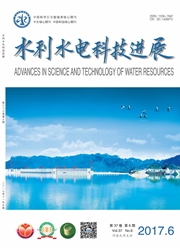

 中文摘要:
中文摘要:
针对山区河道受地质条件及河床演化的影响,其平面形态常呈现宽窄相间的渐变形态特征,采用贴体坐标法剖分正交贴体曲线网格求解域,用有限体积法离散控制方程,以SIMPLER计算程式求解耦合方程,建立山区宽窄相间河道平面二维水流数学模型。将模型计算值与宽窄相间水槽水流试验实测值及水动力学SMS软件计算结果进行比较,结果表明:该模型能够较好地模拟宽窄相间河道平面二维水流运动特性,宽窄相间河道河宽渐变将引起水深和流速的变化,在河道最窄处水深降到最低,流速最大;在河道最宽处水深达到峰值,流速最小。
 英文摘要:
英文摘要:
The plane configuration of river channels in mountainous areas often exhibits gradual characteristics of wide and narrow alternated variations under the effect of geological conditions and riverbed evolution. A two-dimensional mathematical model for wide and narrow alternated river channels in mountainous areas was established by dividing computational domains using the body-fitted coordinates, discretizing governing equations using the finite volume method and solving equation by the SIMPLER algorithm. The model simulations were compared with the observations of flume experiment and the calculated ones by use of the hydrodynamic surface water modeling system (SMS). The results show that the proposed model can satisfactorily depict the two-dimensional flow motion characteristics of wide and narrow alternated river channels. The gradual wide variations of river channels will lead to change of their water depth and velocity. The flow velocity at the narrowest section reaches is the largest and the depth is the smallest. The flow velocity at the widest section is the smallest and the depth is the largest.
 同期刊论文项目
同期刊论文项目
 同项目期刊论文
同项目期刊论文
 Experimental investigation of flow structures and bed deformation with small width-to-depth ratio in
Experimental investigation of flow structures and bed deformation with small width-to-depth ratio in Impact of dissipation and dispersion terms on simulations of open-channel confluence flow using two-
Impact of dissipation and dispersion terms on simulations of open-channel confluence flow using two- Effects of intertidal wetland vegetation and suspended sediment on flow velocity profiles and turbul
Effects of intertidal wetland vegetation and suspended sediment on flow velocity profiles and turbul 期刊信息
期刊信息
